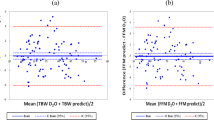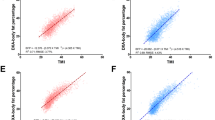Abstract
Objective: To generate equations for the prediction of percent body fat (% BF) via a four-compartment criterion body composition model from anthropometric variables and age.
Design: Multiple regression analyses were used to predict % BF from the best-weighted combinations of independent variables.
Subjects: In all 79 healthy males (X̄±s.d.: 35.0±12.2 y; 84.24±12.53 kg; 179.8±6.8 cm) aged 19–59 y were recruited from advertisements placed in a university newsletter and on community centres' noticeboards.
Interventions: The following measurements were conducted: % BF using a four-compartment (water, bone mineral mass, fat and residual) model and a restricted anthropometric profile (nine skinfolds, five girths and two bone breadths).
Results: Stepwise multiple regression selected six (subscapular, biceps, abdominal, thigh, calf and mid-axilla) of the nine skinfold measurements to predict % BF and using the sum of these six produced a quadratic equation with a standard error of estimate (SEE) and R2 of 2.5% BF and 0.89, respectively. The inclusion of age as a predictor further improved the equation (% BF=−0.00057 × (∑6SF)2+0.298 × ∑6SF+0.078 × age – 1.13; SEE=2.2% BF, R2=0.91). However, the best equation used only the sum of three skinfold thicknesses (mid-axilla, calf and thigh) and age but also included waist girth and biepicondylar femur breadth as predictors (% BF=−0.00258 × (∑3SF)2+0.558 × ∑3SF+0.118 × age+0.282 × waist girth – 2.100 × femur breadth – 2.34; SEE=1.8% BF, R2=0.94). Analyses of two age groups, <30 and ≥30 y, demonstrated that for the same % BF, the former exhibited a higher sum of skinfold thicknesses.
Conclusions: Equations were generated for the prediction of % BF via the four-compartment criterion body composition model from anthropometric variables and age. Agewise differences for the sum of skinfold thicknesses may be related to an increase in internal fat for the older subjects.
Sponsorship: Australian Research Council (small grants scheme).
This is a preview of subscription content, access via your institution
Access options
Subscribe to this journal
Receive 12 print issues and online access
$259.00 per year
only $21.58 per issue
Buy this article
- Purchase on Springer Link
- Instant access to full article PDF
Prices may be subject to local taxes which are calculated during checkout



Similar content being viewed by others
References
Allen TH, Krzywicki HJ & Roberts JE (1959): Density, fat, water, and solids in freshly isolated tissues. J. Appl. Physiol. 14, 1005–1008.
Bliznak J & Staple TW (1975): Roentgenographic measurement of skin thickness in normal individuals. Radiology 116, 55–60.
Brožek J, Grande F, Anderson JT & Keys A (1963): Densitometric analysis of body composition: revision of some quantitative assumptions. Ann. NY Acad. Sci. 110, 113–140.
Brožek J & Kinzey W (1960): Age changes in skinfold compressibility. J. Gerontol. 15, 45–51.
Carlyon RG, Bryant RW, Gore CJ & Walker RE (1998): Apparatus for precision calibration of skinfold calipers. Am. J. Hum. Biol. 10, 689–697.
Carter JEL (1980): The Heath–Carter Somatotype Method, pp 2–4. San Diego: San Diego State University.
Clarys JP, Martin AD, Drinkwater DT & Marfell-Jones MJ (1987): The skinfold: myth and reality. J. Sports Sci. 5, 3–33.
Dahlberg G (1940): Statistical Methods for Medical and Biological Students, pp 122–132. London: Allen and Unwin.
Deurenberg P, Weststrate JA & van der Kooy K (1989): Is an adaptation of Siri's formula for the calculation of body fat percentage from body density in the elderly necessary? Eur. J. Clin. Nutr. 43, 559–568.
Durnin JVGA & Womersley J (1974): Body fat assessed from total body density and its estimation from skinfold thickness: measurements on 481 men and women aged 16 to 72 years. Br. J. Nutr. 32, 77–97.
Fidanza F, Keys A & Anderson JT (1953): Density of body fat in man and other mammals. J. Appl. Physiol. 6, 252–256.
Fomon SJ, Haschke F, Ziegler EE & Nelson SE (1982): Body composition of reference children from birth to age 10 years. Am. J. Clin. Nutr. 35, 1169–1175.
Haschke F, Fomon SL & Ziegler EE (1981): Body composition of a nine-year-old reference boy. Pediatr. Res. 15, 847–849.
Heymsfield SB, Lichtman S, Baumgartner RN, Wang J, Kamen Y, Aliprantis A & Pierson Jr RN (1990): Body composition of humans: comparison of two improved four-compartment models that differ in expense, technical complexity, and radiation exposure. Am. J. Clin. Nutr. 52, 52–58.
Heymsfield SB, Wang J, Kehayias J, Heshka S, Lichtman S & Pierson Jr RN (1989): Chemical determination of human body density in vivo: relevance to hydrodensitometry. Am. J. Clin. Nutr. 50, 1282–1289.
Jackson AS & Pollock ML (1978): Generalized equations for predicting body density of men. Br. J. Nutr. 40, 497–504.
Jackson AS & Pollock ML (1985): Practical assessment of body composition. Phys. Sportsmed. 13, 76–90.
Jackson AS, Pollock ML & Ward A (1980): Generalized equations for predicting body density of women. Med. Sci. Sports Exerc. 12, 175–182.
Lohman TG (1981): Skinfolds and body density and their relation to body fatness: a review. Hum. Biol. 53, 181–225.
Martin AD, Ross WD, Drinkwater DT & Clarys JP (1985): Prediction of body fat by skinfold caliper: assumptions and cadaver evidence. Int. J. Obes. 9, 31–39.
Méndez J, Keys A, Anderson JT & Grande F (1960): Density of fat and bone mineral of the mammalian body. Metabolism 9, 472–477.
Milliken LA, Going SB & Lohman TG (1996): Effects of variations in regional composition on soft tissue measurements by dual-energy X-ray absorptiometry. Int. J. Obes. 20, 677–682.
Norton K (1996): Anthropometric estimation of body fat. In Anthropometrica, eds K Norton & T Olds, pp 171–198. Sydney: University of New South Wales Press.
Norton K, Whittingham N, Carter L, Kerr D, Gore C, & Marfell-Jones M (1996): Measurement techniques in anthropometry. In Anthropometrica, eds K Norton & T Olds, pp 25–75. Sydney: University of New South Wales Press.
Schoeller DA, Ravussin E, Schutz Y, Acheson KJ, Baertschi P & Jéquier E (1986): Energy expenditure by doubly labelled water: validation in humans and proposed calculation. Am. J. Physiol. 250, R823–R830.
Siri WE (1961): Body composition from fluid spaces and density: analysis of methods. In Techniques for Measuring Body Composition, eds J Brožek & A Henschel, pp 223–244. Washington DC: National Academy of Sciences — National Research Council.
Snead DB, Birge SJ & Kohrt WM (1993): Age-related differences in body composition by hydrodensitometry and dual energy X-ray absorptiometry. J. Appl. Physiol. 74, 770–775.
Taylor JR (1982): An Introduction to Error Analysis, pp 52–124. Mill Valley, CA: University Science Books.
van der Ploeg GE, Gunn SM, Withers RT, Modra AC & Crockett AJ (2000): Comparison of two hydrodensitometric methods for estimating percent body fat. J. Appl. Physiol. 88, 1175–1180.
Wellens R, Chumlea WC, Guo S, Roche AF, Reo NV & Siervogel RM (1994): Body composition in white adults by dual-energy X-ray absorptiometry, densitometry, and total body water. Am. J. Clin. Nutr. 59, 547–555.
Williams DP, Going SB, Lohman TG, Hewitt MJ & Haber AE (1992): Estimation of body fat from skinfold thicknesses in middle-aged and older men and women: a multiple component approach. Am. J. Hum. Biol. 4, 595–605.
Withers RT, Craig NP, Bourdon PC & Norton KI (1987): Relative body fat and anthropometric prediction of body density of male athletes. Eur. J. Appl. Physiol. Occup. Physiol. 56, 191–200.
Withers RT, LaForgia J & Heymsfield SB (1999): A critical appraisal of the estimation of body composition via two-, three-, and four-compartment models. Am. J. Hum. Biol. 11, 175–185.
Withers RT, LaForgia J, Pillans RK, Shipp NJ, Chatterton BE, Schultz CG & Leaney F (1998): Comparisons of two-, three-, and four-compartment models of body composition analysis in men and women. J. Appl. Physiol. 85, 238–245.
Womersley J, Durnin JVGA, Boddy K & Mahaffy M (1976): Influence of muscular development, obesity and age on the fat-free mass of adults. J. Appl. Physiol. 41, 223–229.
Author information
Authors and Affiliations
Corresponding author
Rights and permissions
About this article
Cite this article
van der Ploeg, G., Gunn, S., Withers, R. et al. Use of anthropometric variables to predict relative body fat determined by a four-compartment body composition model. Eur J Clin Nutr 57, 1009–1016 (2003). https://doi.org/10.1038/sj.ejcn.1601636
Received:
Revised:
Accepted:
Published:
Issue Date:
DOI: https://doi.org/10.1038/sj.ejcn.1601636
Keywords
This article is cited by
-
Predictive equations for fat mass in older Hispanic adults with excess adiposity using the 4‐compartment model as a reference method
European Journal of Clinical Nutrition (2023)
-
Body composition analysis in older adults with dementia. Anthropometry and bioelectrical impedance analysis: a critical review
European Journal of Clinical Nutrition (2014)
-
Accuracy of Siri and Brozek equations in the percent body fat estimation in older adults
The Journal of nutrition, health and aging (2010)
-
Predictive Equations for Body Fat and Abdominal Fat With DXA and MRI as Reference in Asian Indians
Obesity (2008)
-
Two‐dimensional Predictive Equation to Classify Visceral Obesity in Clinical Practice
Obesity (2006)



